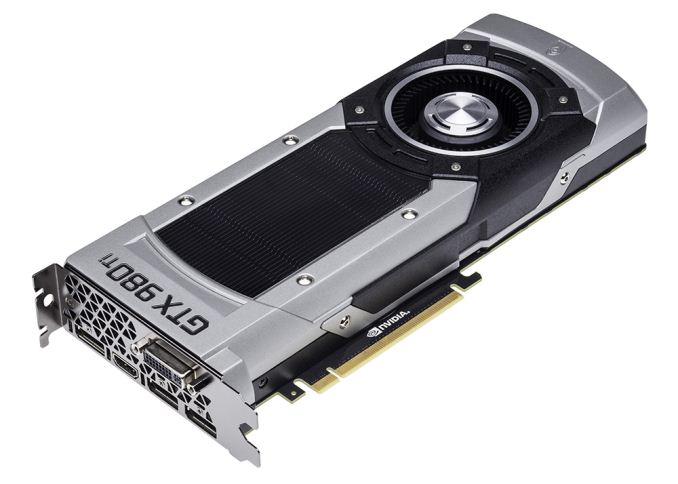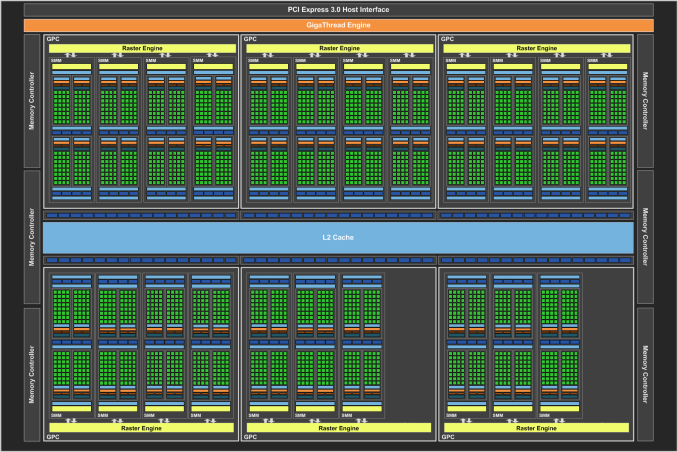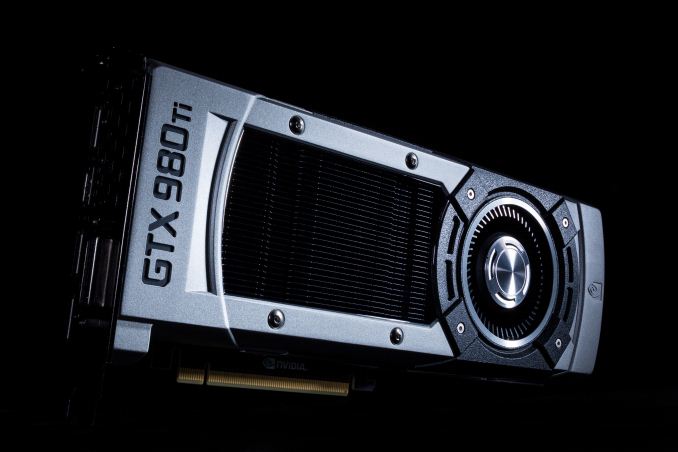The NVIDIA GeForce GTX 980 Ti Review
by Ryan Smith on May 31, 2015 6:00 PM EST
For much of the last year now, the story of the high-end video card market has been the story of NVIDIA. In September of 2014 the company launched the GeForce GTX 980, the first and at the time most powerful member of their Maxwell 2 architecture, setting a new mark for both power efficiency and performance, securing their lead of high-end of the video card market. NVIDIA then followed that up in March with the launch of the GeForce GTX Titan X, NVIDIA’s true flagship Maxwell part, and a part that only served to further cement their lead.
Based on the very powerful (and very large) GM200 GPU, GTX Titan X is currently untouched in performance. However priced at $1000, it is also currently untouched in price. In NVIDIA’s current lineup there is a rather sizable gap between the $550 GTX 980 and $1000 GTX Titan X, and perhaps more significantly GTX Titan X was the only GM200 part on the market. With NVIDIA launching their fully enabled flagship card first, it was only a matter of time until they released a cheaper card based on a cut-down version of the GM200 GPU in order to fill that pricing hole and to put salvaged GM200s to good use.
Now just a bit over two months since the launch of the GTX Titan X, NVIDIA launching their second GM200 card, GeForce GTX 980 Ti. Based on the aforementioned cut-down version of GM200, GTX 980 Ti is the expected junior version of GTX Titan X, delivering GM200 at a cheaper price point. But calling GTX 980 Ti a cheaper GM200 may be selling it short; “cheaper” implies that GTX 980 Ti is a much lesser card. At $649, GTX 980 Ti is definitely cheaper, but the card that is launching today is not to be underestimated. GTX 980 Ti may be intended to be GTX Titan X’s junior, but with the excellent performance it delivers, GTX 980 Ti may as well be GTX Titan X itself.
| NVIDIA GeForce Specification Comparison | ||||||
| GTX Titan X | GTX 980 Ti | GTX 980 | GTX 780 Ti | |||
| CUDA Cores | 3072 | 2816 | 2048 | 2880 | ||
| Texture Units | 192 | 176 | 128 | 240 | ||
| ROPs | 96 | 96 | 64 | 48 | ||
| Core Clock | 1000MHz | 1000MHz | 1126MHz | 875MHz | ||
| Boost Clock | 1075MHz | 1075MHz | 1216MHz | 928Mhz | ||
| Memory Clock | 7GHz GDDR5 | 7GHz GDDR5 | 7GHz GDDR5 | 7GHz GDDR5 | ||
| Memory Bus Width | 384-bit | 384-bit | 256-bit | 384-bit | ||
| VRAM | 12GB | 6GB | 4GB | 3GB | ||
| FP64 | 1/32 FP32 | 1/32 FP32 | 1/32 FP32 | 1/24 FP32 | ||
| TDP | 250W | 250W | 165W | 250W | ||
| GPU | GM200 | GM200 | GM204 | GK110B | ||
| Architecture | Maxwell 2 | Maxwell 2 | Maxwell 2 | Kepler | ||
| Transistor Count | 8B | 8B | 5.2B | 7.1B | ||
| Manufacturing Process | TSMC 28nm | TSMC 28nm | TSMC 28nm | TSMC 28nm | ||
| Launch Date | 03/17/2015 | 06/01/2015 | 09/18/2014 | 11/07/2013 | ||
| Launch Price | $999 | $649 | $549 | $699 | ||
Taking a look at GTX 980 Ti from a specifications perspective, NVIDIA’s latest card is in a somewhat unusual place. Its direct predecessor, GTX 780 Ti, was a fully enabled GK110 card, differing from that generation’s Titan only in double precision compute capabilities and a trivial clockspeed difference. However with GM200 being a pure graphics chip – and hence GTX Titan X not pulling double-duty as a prosumer level compute card – NVIDIA has needed to turn to cutting down the chip itself in order to differentiate the products. In this sense the GTX 980 Ti is probably closer to being the GTX 780 of its generation, a very timely situation given the fact that GTX 780 launched almost exactly 2 years ago.
In any case, compared to GTX Titan X NVIDIA has made just two changes to create GTX 980 Ti. The first is that the company has disabled 2 of GM200’s 24 SMMs, bringing it down to 22 SMMs for a total of 2816 active CUDA cores. The second change was to dial back the amount of VRAM, from GTX Titan X’s 12GB to the 6GB we see on GTX 980 Ti. And that’s it.
In every other aspect the GTX 980 Ti is identical to the GTX Titan X. Both are clocked at 1000MHz, with a boost clock of 1075MHz. Both feature their VRAM on a 384-bit memory bus with their respective VRAM modules clocked at 7GHz. Both are set for a 250W TDP, and are equipped with NVIDIA’s high end metal-shrouded cooler. And finally, GTX 980 Ti retains all 96 ROPs and 3MB of L2 cache, which means that in pixel-heavy situations like 4K it is as no disadvantage compared to GTX Titan X.
Consequently, looking at the specifications tells us that we should expect GTX 980 Ti to be 8% slower than GTX Titan X, a result of losing 2 SMMs. Coupled with the difference in VRAM between the two cards, this would put a decent gap between the two cards. However as we’ll see in our benchmarks, reality begs to differ. Thanks to the combination of a couple of factors GTX 980 Ti ends up coming much closer to GTX Titan X than what the specifications tell us to expect. In the end what we find is that it delivers 97% of GTX Titan X’s performance. This, in a nutshell, is what makes GTX 980 Ti a deceptive card, and is why it’s going to have such a large impact on the high-end market.
Shifting gears, let’s talk about pricing, availability, and the competition. The GTX 980 Ti will be a hard launch, with cards going on sale on June 1st. Due to the fact that Computex is taking place this week in Taiwan and GTX 980 Ti is one of the products NVIDIA is launching at the show, NVIDIA has lifted the embargo on GTX 980 Ti at an atypical 6pm Eastern, which for Taiwan and Computex is June 1st, 6am local time. NVIDIA is launching the card globally on the 1st, so in a reversal of typical launches APAC buyers will get first dibs on the card, followed by European and North/South American buyers several hours later. Along with the GTX 980 Ti reference cards launching today, expect to see semi-custom cards launching very soon thereafter.
Meanwhile for pricing, the GTX 980 Ti will be launching at $649. This is an increasingly persistent price point for NVIDIA that has fluctuated a bit over the last couple of years, with the GTX 780 launching at $649 as well, only for the GTX 780 Ti to launch at $699. The launch of GTX 980 Ti at $649 will be putting pressure on the rest of NVIDIA’s product stack from both above and below. In response to this launch NVIDIA is officially cutting the price of the GTX 980 from $549 to $499 in order to open up a bit more room between the cards and to keep GTX 980 Ti from making GTX 980 redundant. At the same time however GTX 980 Ti puts enormous pressure on GTX Titan X; GTX 980 Ti’s performance is close enough to GTX Titan X that the latter’s only practical advantage is its 12GB of VRAM, and that’s not a lot to justify the Titan’s $350 (54%) price premium.
Not stopping there, in an unusual move for NVIDIA the GTX 980 Ti is getting a game bundle right off the bat. The card isn’t getting NVIDIA’s full Two Times The Adventure bundle that comes with the GTX 980, but it is getting a copy of the forthcoming Batman: Arkham Knight, another one of this year’s major GameWorks titles. The end result is that NVIDIA is being more aggressive than usual this time around, offering what amounts to a GTX Titan X and a game for $649.
Of course the competition may have something to do with it. AMD is pretty much shouting from the rooftops that they are launching a new high-end video card this quarter, which at this point means the card is due by the end of June. While NVIDIA does have other financial incentives for releasing GTX 980 Ti now that GTX Titan X has been on the market for a couple of months, by all appearances this looks to be NVIDIA making the first move. We’ll have to see just what AMD delivers next month, but what is clear is that whatever they do, NVIDIA will not be making it easy by delivering flagship performance at $649.
In the meantime AMD and their partners are also still selling the Radeon R9 295X2 for around $600, though it looks like this is part of an effort to sell off the remaining inventory of cards. AMD has no other cards in this price range, so the GTX 980 Ti is otherwise uncontested until AMD’s new card launches.
| Summer 2015 GPU Pricing Comparison | |||||
| AMD | Price | NVIDIA | |||
| $999 | GeForce GTX Titan X | ||||
| $649 | GeForce GTX 980 Ti | ||||
| Radeon R9 295X2 | $599 | ||||
| $499 | GeForce GTX 980 | ||||
| Radeon R9 290X | $319 | GeForce GTX 970 | |||
| Radeon R9 290 | $250 | ||||












290 Comments
View All Comments
Kosiostin - Monday, June 1, 2015 - link
I beg to differ. 4K at monitor viewing distance is not overkill, it's actually quite pleasantly sharp. Phones, tablets and laptops are already pushing for 2K+ displays which is phenomenally sharp and out of the league for normal FHD monitors. Gaming at 4K is still not coming but when it comes it will blow our minds, I am sure.Oxford Guy - Monday, June 1, 2015 - link
People who care so much for immersion should be using 1440 with HDTV screen sizes, not sitting way up close with small monitors.Too bad HDTVs have so much input lag, though.
Kutark - Monday, June 1, 2015 - link
Basically at a 5' viewing distance, you would have to have a 40" monitor before 4k would start to become noticeable.Even at 30" monitor you would have to be sitting roughly 3.5' or closer to your monitor to be able to begin to tell the difference.
We also have to keep in mind we're talking about severely diminishing returns. 1440p is about perfect for normal seating distances with a computer on a 27" monitor. 30" some arguments can be made for 4k but its a minor. Its not like we're going from 480p to 1080p or something 1440p is still very good at "normal" computer seating distances.
mapesdhs - Wednesday, June 3, 2015 - link
Human vision varies as to who can discern what at a particular distance. There's no fixed cutoffs for this. Personally, when wandering around a TV store back in January (without knowing what type of screen I was looking at), for visual clarity the only displays that looked properly impressive turned out to be 4Ks. However, they're still a bit too pricey atm for a good one, with the cheaper models employing too many compromises such as reduced chroma sampling to bring down the pricing, or much lower refresh rates, etc. (notice how stores use lots of static imagery to advertise their cheaper 4K TVs?)Btw, here's a wonderfull irony for you: recent research, mentioned in New Scientist, suggests that long exposure by gamers to high-refresh displays makes them more able to tell the difference between standard displays and high-refresh models, ie. simply using a 144Hz monitor can make one less tolerant of standad 60Hz displays in the long term. :D It's like a self-reinforcing quality tolerance level. Quite funny IMO. No surprise to me though, years working in VR & suchlike resulted in my being able to tell the difference in refresh rates much more than I was able to beforehand.
Anyway, I'm leaving 4K until cheaper models are better quality, etc. In the meantime I bought a decent (but not high-end) 48" Samsung which works pretty well. Certainly looks good for Elite Dangerous running off a 980, and Crysis looks awesome.
Laststop311 - Monday, June 1, 2015 - link
Why would most people be using DVI? DVI is big and clunky and just sucks. Everyone that gets new stuff nowadays uses displayport it has the easiest to use plug.Crest - Sunday, May 31, 2015 - link
Thank you for including the GTX580. I'm still living and working on a pair of 580's and it's nice to know where they stand in these new releases.TocaHack - Monday, June 1, 2015 - link
I upgraded from SLI'd 580s to a 980 at the start of April. Now I'm wishing I'd waited for the Ti! It wasn't meant to launch this soon! :-/mapesdhs - Wednesday, June 3, 2015 - link
Indeed, one of the few sites to include 580 numbers, though it's a shame it's missing in some of the graphs (people forget there are lots of 3GB 580s around now, I bought ten last month).If it's of any use, I've done a lot of 580 SLI vs. 980 (SLI) testing, PM for a link to the results. I tested with 832MHz 3GB 580s, though the reference 783MHz 3GB models I was already using I sold for a nice profit to a movie company (excellent cards for CUDA, two of them beat a Titan), reducing the initial 980 upgrade to a mere +150.
Overall, a 980 easily beats 580 SLI, and often comes very close to 3-way 580 SLI. The heavier the load, the bigger the difference, eg. for Firestrike Ultra, one 980 was between 50% and 80% faster than two 3GB 580s. I also tested 2/3-way 980 SLI, so if you'd like the numbers, just PM me or Google "SGI Ian" to find my site, contact page and Yahoo email adr.
I've been looking for a newer test. I gather GTA V has a built-in benchmark, so finally I may have found something suitable, need to look into that.
Only one complaint about the review though, why no CUDA test??? I'd really like to know how the range of NV cards stacks up now, and whether AE yet supports MW CUDA V2. I've tested 980s with Arion and Blender, it came close to two 580s, but not quite. Would be great to see how the 980 Ti compares to the 980 for this. Still plenty of people using CUDA with pro apps, especially AE.
Ian.
mapesdhs - Wednesday, June 3, 2015 - link
Btw Crest, which model 580s are you using? I do have some 1.5GB 580s aswell, but I've not really done much yet to expose where VRAM issues kick in, though it does show up in Unigine pretty well at 1440p.For reference, I do most testing with a 5GHz 2700K and a 4.8GHz 3930K, though I've also tested three 980s on a P55 with an i7 870 (currently the fastest P55 system on 3DMark for various tests).
Mikemk - Sunday, May 31, 2015 - link
Since it has 2 SMM's disabled, does it have the memory issue of the 970? (Haven't read full article yet, sorry if answered in article)